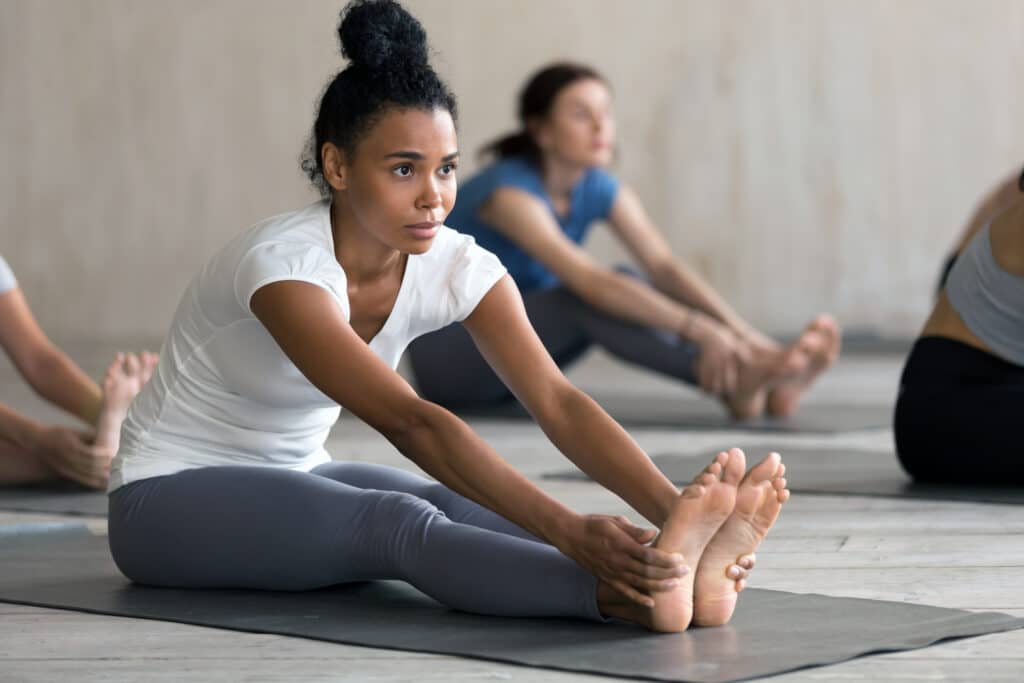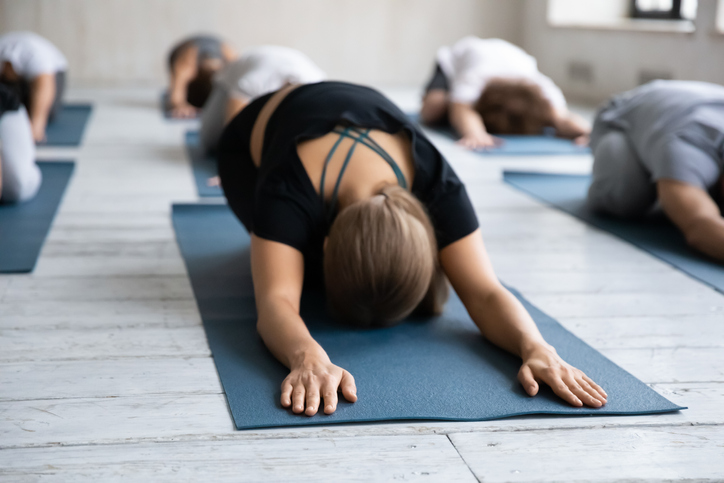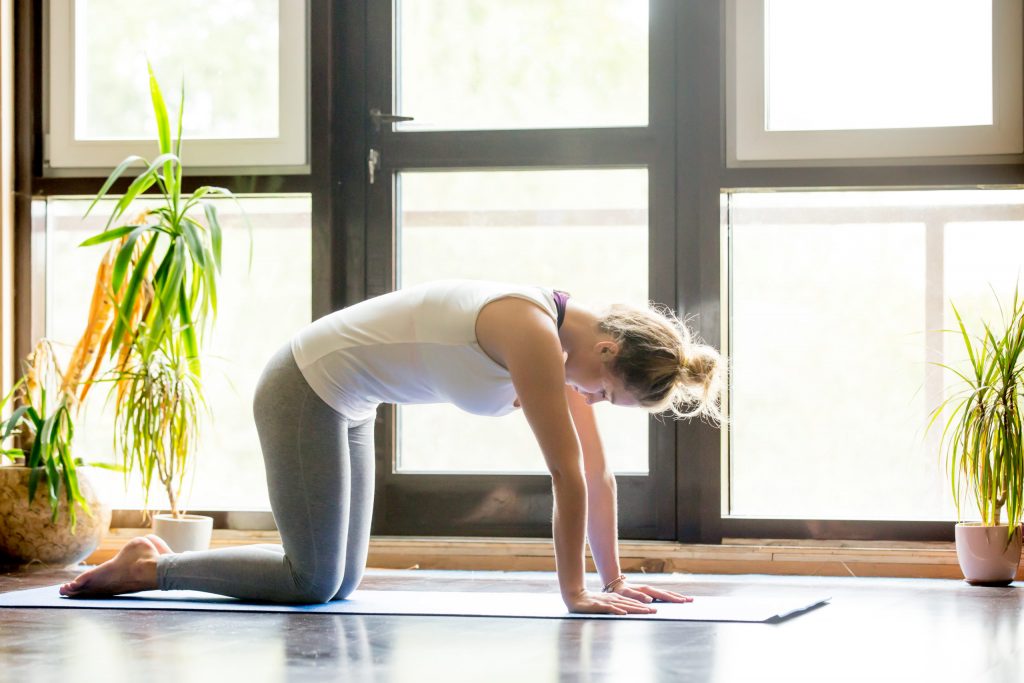Tight, achy back? These low back stretches and simple exercises could be your fast track to relief.
Low back pain affects nearly 31 million Americans at any given time, according to the American Chiropractic Association. Whether it stems from sitting too long, lifting improperly, or underlying issues like disc injuries or muscle imbalances, back pain can significantly affect quality of life.
The good news? Gentle, intentional movement can offer powerful relief. This guide will walk you through effective stretches and exercises to help relieve low back pain, explain common root causes, and give you quick-reference tools to choose the right moves for your needs.
What Causes Low Back Pain?

Low back pain can be caused by a variety of conditions, lifestyle factors, or repetitive movement patterns. Understanding the source of your discomfort – especially if your back pain is happening at work – is the first step to lasting relief. Some common causes of low back pain include:
- Muscle strains or ligament sprains
- Herniated or bulging discs
- Poor posture or spinal misalignment
- Weak core or glutes
- Tight hips or hamstrings
- Pregnancy or postpartum recovery
- Arthritis or degenerative disc disease
- Stress and muscle tension
- Chronic inflammation
Because there are so many causes of back pain, you should always consult with a chiropractor or medical professional before beginning any new exercise regimen, especially if pain is severe or persistent.
Movement Can Help You Move & Heal Faster
Movement is one of the most powerful and underutilized tools for managing and healing low back pain. While rest may seem like the right response to discomfort, prolonged inactivity can actually worsen symptoms by weakening core muscles and reducing mobility. In contrast, consistent, gentle movement keeps the spine nourished and flexible while building strength in the muscles that support it.
“Stretching is one of the simplest yet most effective ways to reduce low back pain and prevent future flare-ups. Just a few minutes a day can improve flexibility, ease tension, and help support a stronger, more stable spine.”
- Dr. Shawn Ebaugh, Chiropractor at AlignLife Woodridge, IL
When performed correctly, therapeutic movements and low back stretches can:
- Promote spinal alignment and hydrate intervertebral discs, keeping them pliable and functional
- Relieve muscular tension by encouraging blood flow and oxygen delivery to tight, inflamed tissues
- Improve posture and joint mobility, which helps reduce the strain that leads to pain
- Strengthen supportive muscles including the glutes, core, and hips—essential for maintaining proper movement mechanics
Unlike high-impact workouts, targeted low back exercises and stretches work with your body’s natural mechanics to rebuild stability from the inside out. Even just a few minutes a day can lead to noticeable improvements in comfort and function.
Below are top stretches and exercises grouped by symptom or cause so you can personalize your routine.
Quick Reference: Low Back Stretches by Cause
| Issue or Cause | Recommended Stretches/Exercises |
|---|---|
| Tight hamstrings | Rag Doll Forward Fold, Seated Hamstring Stretch |
| Hip flexor tightness | Runner's Lunge, Pigeon Pose |
| Core weakness | Bird Dog, Wall Sits, Dead Bug |
| Glute or piriformis tightness | Figure 4 Stretch, Bridge Pose |
| Herniated disc/sciatica | Cobra Press-Up, Bird Dog |
| SI joint dysfunction | Bridge Pose, Pelvic Tilts |
| General spinal stiffness | Cat-Cow Stretch, Supine Twist |
| Stress-related tension | Child’s Pose, Seated Forward Fold |
| Postural imbalances | Single Knee-to-Chest, Seated Forward Fold |
Top Stretches for Low Back Relief
These stretches are designed to gently release tension, increase flexibility, and promote spinal mobility. They’re a great way to start or end your day, reduce stiffness, and support recovery from common postural stressors.
1) Rag Doll Forward Fold

This gentle inversion harnesses gravity to help decompress the spine, loosen tight hamstrings, and release tension from the entire posterior chain. It’s ideal for people who sit or stand for long periods and need a quick way to reset spinal alignment.
How to do it:
- Stand with feet hip-width apart
- Bend knees slightly and hinge forward
- Hold opposite elbows and relax the head
- Hold for 5 deep breaths
2) Runner’s Lunge

This deep hip opener targets the psoas, a core muscle group that often becomes tight due to prolonged sitting or postural imbalances. Releasing the psoas helps reduce pull on the lumbar spine and relieve back tension.
How to do it:
- Start on hands and knees
- Step one foot forward into a lunge, keeping back leg extended
- Tuck pelvis under slightly
- Hold for 15 seconds, 3 reps per side
3) Figure 4 Stretch (Lying)

This stretch relieves deep-seated tension in the glutes and piriformis muscle, which can compress the sciatic nerve and contribute to lower back discomfort. It’s especially beneficial after sitting for long periods.
How to do it:
Lie on back, knees bent
Cross ankle over opposite knee
Pull bottom leg toward chest and hold
Hold for 3 breaths, repeat each side 3x
4) Supine Twist

A gentle spinal rotation that hydrates discs, improves mobility, and eases lower back tension. It’s a perfect cool-down stretch that also aids digestion and reduces stress.
How to do it:
- Lie in a T position
- Bring knees to chest, then drop both to one side
- Hold for 3–4 deep breaths, repeat on other side
5) Single Knee-to-Chest

This simple stretch helps elongate the lower spine, relieve tightness in the glutes, and decompress the lower back. It’s a great option for morning or evening routines.
How to do it:
- Lie flat on back
- Pull one knee to chest and hold
- Switch sides, 3 reps each
6) Seated Forward Fold

A classic stretch for tight hamstrings and lower back tension, this pose calms the nervous system while gently lengthening the spine and hips.
How to do it:
- Sit on the floor with legs extended straight
- Inhale and reach arms overhead
- Exhale and fold forward from the hips, reaching toward the toes
- Hold for 3–5 deep breaths
7) Child’s Pose

This restorative yoga posture helps release tension in the lumbar spine, hips, and shoulders while calming the nervous system.
How to do it:
- Begin on all fours
- Sit hips back toward heels, reaching arms forward or placing them by your sides
- Rest forehead on the ground and breathe deeply for 30 seconds to 1 minute
8) Cat-Cow Stretch

This gentle spinal articulation improves flexibility in the lumbar spine and helps relieve stiffness from prolonged sitting.
How to do it:
- Start on hands and knees in a tabletop position
- Inhale, arch your back (Cow), lifting head and tailbone
- Exhale, round the spine (Cat), tucking chin and pelvis
- Repeat for 5–10 full cycles
“These stretches are a great way to manage pain between visits, but they work best when combined with chiropractic care. When your spine is aligned and your muscles are balanced, your body can heal and move the way it was designed to.”
- Dr. Clay Baker, Chiropractor at AlignLife Tryon, NC
Top Exercises to Support Low Back Strength
In addition to stretching, strengthening the muscles that support your spine is essential for long-term relief and injury prevention. Exercises like Bird Dog, Wall Sits, and Cobra Press-Ups help build core stability and glute strength—two of the most important factors in supporting a healthy lower back.
However, these are just a few of the many gentle and effective movements you can use to improve back health. For a deeper dive into more exercises that promote low back mobility, strength, and support, be sure to read our full guide: 8 Simple Exercises to Maintain Low Back Mobility.
- Wall Sits: Build muscular endurance in the glutes, quads, and hamstrings, which support the spine and improve posture. Stand against a wall with feet hip-width apart, slide down until knees are at a 90-degree angle, hold for 20–30 seconds, and repeat 3 times.
- Standing Knee Raises: Strengthen the hip flexors and core to enhance balance and spinal support. Stand tall, raise one knee to chest, lower, and repeat 15 times per leg. Use a chair for support if necessary.
- Bird Dog Extensions: Improve core stability and spine alignment through controlled limb movements. Begin on hands and knees, extend opposite arm and leg, hold for a breath, then switch. Repeat 3 times per side.
- Bridge Pose: Strengthen glutes and lower back to support the sacroiliac joint and relieve lumbar tension. Lie on your back with knees bent, lift hips toward the ceiling, pause at the top, lower, and repeat 5 times.
- Cobra Press-Up (Prone Extension): Decompress the spine and relieve disc-related discomfort. Lie face down with hands beneath shoulders, press chest up while keeping pelvis grounded, lower slowly, and repeat 5 times.
Build a Low Back Stretch Routine That Works

To build an effective low back stretch routine:
- Choose 3–5 stretches that target your specific issue from the Quick Reference Chart
- Perform them daily, ideally in the morning when muscles are less tense
- Breathe deeply during each stretch to promote relaxation and circulation
- Add in 2–3 strengthening exercises to help strengthen and stabilize your core
- Modify your movements as needed to accommodate your flexibility or mobility level
Be sure to also schedule a visit with your local AlignLife Chiropractor to see how we can help you heal and find lasting relief. We can assess your spinal alignment, identify imbalances, and guide you toward a customized healing plan.



